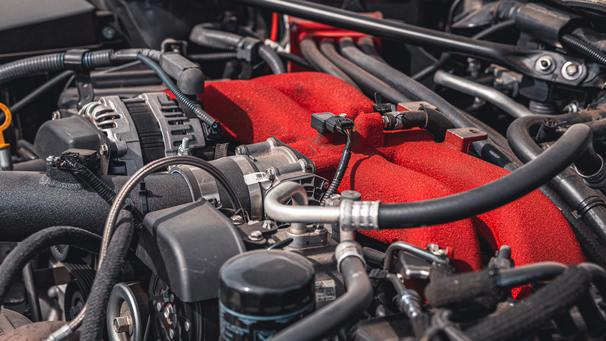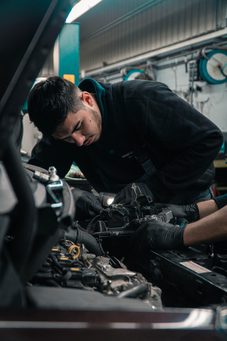There is a risk that your car’s engine might be damaged by a coolant leak, even if it seems to be little. Your engine might overheat if you don’t use enough antifreeze. Coolant should be examined frequently due to its importance in engine performance. Particularly in the case of more aged automobiles, which may not run at the same level of efficiency as more recent versions.
The most apparent sign of a cracked coolant reservoir is a pool of fluid on the floor of your garage. Identifying the fluid from which your engine is leaking might be tricky since it’s not the only fluid that can go bad in your engine. As a rule, the color of the coolant is generally brilliant green, orange, or pink and the scent is sweet.
You may also check your temperature gauge to see if you have a coolant leak. In general, a sudden or considerable temperature shift is an indication that there is an issue that has to be addressed before it does any harm.
Check the coolant level in the expansion tank to see if you’re losing fluid to determine whether your engine leaks.
Causes Of Cracked Coolant Reservoir
Age
Coolant reservoirs are often made from plastic and over time they can become brittle and crack.
Temperature Changes
Rapid temperature changes can cause the plastic to expand and crack.
Corrosion
The metal parts in the coolant system can corrode which will cause the reservoir to leak.
Pressure
The coolant system is under a lot of pressure and if there is a weak spot in the reservoir, it can cause it to crack.
Impact
If the coolant reservoir is hit by something, it can crack and start to leak.
Symptoms Of Cracked Coolant Reservoir
Coolant Leak
One of the most common symptoms of a cracked coolant reservoir is a coolant leak.
Overheating Engine
If you’re not using enough antifreeze, your engine can overheat.
Temperature Gauge Shifting
A sudden or considerable temperature shift is an indication that there is an issue that needs to be addressed.
Low Coolant Levels
You can check the coolant level in the expansion tank to see if you’re losing fluid.
High Engine Temperatures
If the engine temperature is consistently high, it could be a sign of a coolant leak.
How To Fix A Cracked Coolant Reservoir
Stop The Leak
If you have a cracked coolant reservoir, you need to stop the leak before it does any more damage.
Replace The Reservoir
If the reservoir is cracked, you’ll need to replace it.
Repair The Damage
If the reservoir is not cracked, but the damage is more than just a surface scratch, you can try to repair it.
Tighten The Bolts
If the reservoir is not cracked, but the bolts are loose, you can try to tighten them.
Add A Sealant
If the reservoir is not cracked, and the bolts are tight, you can try to add a sealant.
What Are The Causes Of Coolant Leaks
The Radiator Has A Hole In It
All of your car’s engine components are subjected to a lot of wear and severe temperatures, and they all take a toll. One of the most common causes of coolant leaks is corrosion inside the radiator. You may have silt or other material within the tubes as they become older and weaker, causing a leak. Leaks may occur if the gasket between the radiator and the tank wears out.
The radiator hoses might potentially be the source of the leak; as they age, they become hard and brittle, making it difficult for them to properly seal. Because of this, the radiator, water pump, and heater core are all at risk of leaking.
Radiator Cap Leaks Out
Despite its tiny size, the radiator cap performs a significant function. Keeping the cooling system at the correct pressure is the responsibility of the radiator cap, which is heavily pressured. However, with time, the seal or spring may degrade, allowing the coolant to leak from the device.
You Have A Blown Head Gasket
Your car’s head gasket has a significant impact on the performance of your engine. It’s possible that you won’t be aware that your head gasket has failed for some time. You may not notice an issue until you’ve driven for a while. The head gasket must be able to withstand a broad variety of temperatures and pressures in the engine. It is referred to be “blown” when it develops a leak between the cylinder head and the engine block.
If this occurs, the engine oil and coolant will no longer be able to be separated, which is exceedingly hazardous and may lead to engine failure. Coolant may also leak out of the engine, reducing your car’s capacity to maintain a cool temperature.
Failure Of Water Pump
By pumping water into the cooling system, the water pump guarantees that coolant is being circulated throughout the cooling system. It is located in the engine’s lower part, near the drive belts. Over time, the hose connection to the radiator’s bottom hose may break loose or be corroded. It might also be the result of any kind of external harm.
Regardless matter the reason, your engine will ultimately overheat if your water pump malfunctions and is unable to circulate coolant throughout the system.
An Expansion Tank Problem
The expansion tank, the plastic container next to the engine, is there to aid with coolant supplies to the radiator. When the engine warms up or cools down, a rubber tube connects it to the radiator and transfers coolant between the two.
The plastic and the pieces linked to it may degrade with time and in the face of temperature fluctuations. If the container breaks or the cap leaks, coolant will be able to escape. It’s also possible that the radiator hose degrades with time, causing a slack connection and allowing fluid to escape.
How To Prevent Coolant Leaks
Changing the coolant in your radiator regularly is one technique to avoid coolant leaks from occurring in the first place. The aluminum in your radiator may be eaten away by sour coolant, which turns acidic and corrodes the metal.
A leaky radiator may be prevented with routine maintenance, which can identify loose and failing hoses and other issues.
If you see evidence of coolant leaking, you should take your vehicle to a mechanic so that they can identify the issue and repair it. To avoid an overheated engine, you must keep your automobile cool during summer.
Final Thoughts
If you’re experiencing any of the symptoms of a cracked coolant reservoir, it’s important to address the issue as soon as possible. There are several ways to fix a cracked coolant reservoir, so take action before the problem gets worse.


